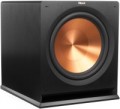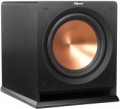Power
Rated power of the subwoofer. Technically, this is the highest average (rms) sound power at which the device can work normally (without sound distortion and damage to components) for an unlimited time. Simply put, the more powerful the subwoofer, the louder it is. The choice for this parameter depends primarily on the size of the space / room that is planned to be covered; detailed recommendations for different situations can be found in special sources.
Also, the power is directly related to the characteristics of the amplifier used with the subwoofer. For active subwoofers (see "Type"), this item actually indicates the nominal power of the built-in amplifier; the speaker itself can be more powerful, but it doesn't matter anymore. For passive models, the power rating corresponds to the highest amplifier power that can be connected to the speaker without the risk of damaging it at high volume.
Max. sound pressure level
The highest sound pressure level that a subwoofer can create, in other words, the volume that it produces at its maximum power level. This parameter is measured in the same way as any noise level - in decibels; since the decibel is a non-linear quantity, it is easiest to evaluate loudness using comparative tables. So, the most modest modern subwoofers are capable of delivering up to 95 – 100 dB, this is comparable to the volume of a subway car or a chainsaw. In the most powerful ones, it can exceed 130 dB - this is louder than an airplane on takeoff, a long stay near a subwoofer operating at full power can lead to hearing damage.
Note that sound pressure and sensitivity (see above) are fundamentally different characteristics, although they are measured by the same units.
Frequency range
The range of audio frequencies reproduced by the subwoofer. As a general rule, the wider the frequency range, the richer the sound and the more detail the speaker can convey. However, it is worth remembering that subwoofers as a class are designed for low and ultra-low frequencies in the range from 20 to 150 (sometimes 200) Hz. Therefore, in fact, a significant difference in sound is noticeable only with a large difference in the reproducible ranges (for example, 20-200 Hz and 50-150 Hz).
Also, do not forget that an extensive frequency range is not yet a guarantee of high-quality sound; and in some cases (for example, if the main speakers of the speaker also cope well with low frequencies), it may be completely redundant.
Speaker size
The diameter of the speaker(s) installed in the subwoofer.
It is believed that the larger the speaker (
15 ",
18 " and more), the more power it can produce and the deeper the bass will be on such acoustics. However, in modern subwoofers, manufacturers use various tricks that allow achieving good sound depth even with relatively small speaker sizes (
10 ",
8 "). Therefore, it is possible to compare different models only if they differ significantly in this indicator; and even then, in such cases, it is worth paying attention not so much to the speaker diameter as to the price category. The golden mean among sizes is
12-inch subwoofers.
Phase adjustment
The ability to shift the sound produced by the subwoofer in phase — usually by 180 °, but in some models the option is also available by 90 °.
Sound vibrations can be represented as a sinusoid. In some cases, the sinusoids from the subwoofer and from the main speakers may be out of phase — for example, with a difference in distance, inconsistency in the operation of amplifiers, etc. This degrades the sound quality. And
the phase adjustment allows you to correct the situation and coordinate the subwoofer with the rest of the components of the speaker system.
Level adjustment
The subwoofer has its own
level control, in other words, a volume control. Adjusting the bass with such a control is often easier than digging into the settings of an amplifier or other external device.
Adjustable crossover
The presence of an
adjustable crossover in the design of the subwoofer.
A crossover is a device that divides the audio signal into separate frequency bands and directs each band to "its own" speakers. See "Crossover Frequency" for more on this. Here we note that the adjustable crossover allows you to change the upper threshold of the frequencies supplied to the subwoofer. This allows you to optimally match the bass speaker with the main speakers — so that, on the one hand, the bass does not overlap, on the other, there is no gap between the subwoofer and the rest of the acoustics.

